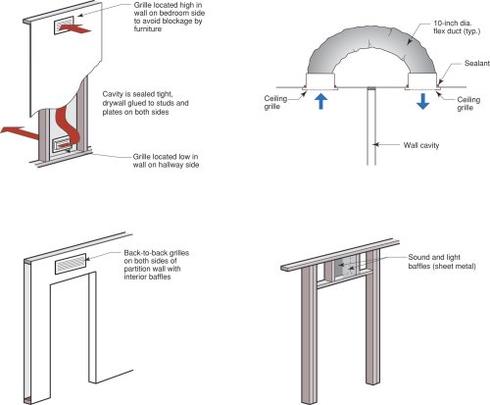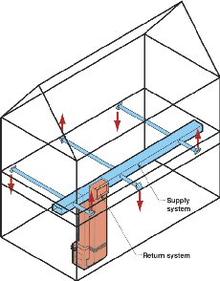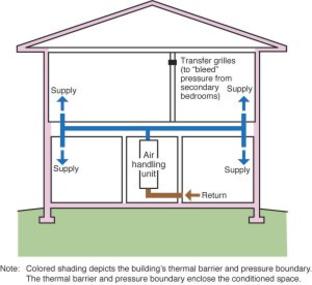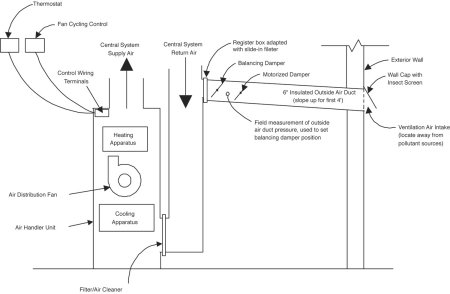This two-story slab-on-grade enclosure is designed for Sacramento, CA (Hot-Dry/Mixed-Dry Climate). It features a vented attic with a raised heel truss and cavity insulation at the attic floor, and clay tiles. The 2x6 advanced wood frame walls are insulated with cavity insulation and 1” rigid insulation on the exterior of the wall sheathing, and feature a stucco finish. The rim joist is insulated with cavity insulation on the interior and the slab is left uninsulated.
Enclosure Design
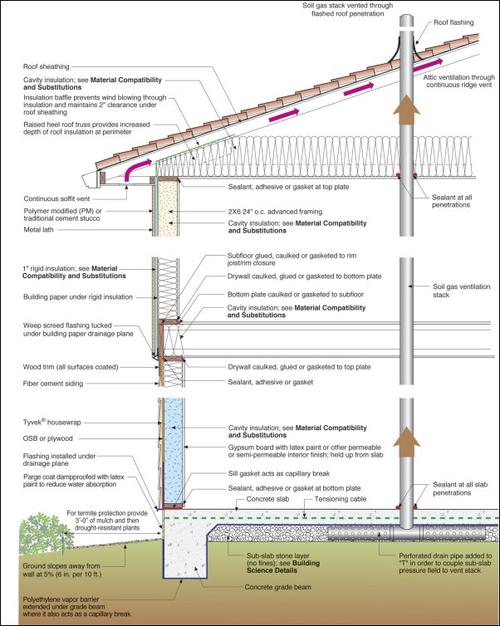
Construction Recommendations
- Foundation: Post-tensioned slab-on-grade
- Above Grade Wall: Wood frame
- Cladding (1st floor): Fiber cement siding; (2nd floor): Stucco
- Attic: Unconditioned
- Roof: Tile
Building Science Notes
Ducts in conditioned space - This building profile is designed to accommodate HVAC equipment and ducts in the living space. Specifically, the duct system is a blow up/blow down configuration located in either the second floor framing or an extensive network of dropped soffits. Use of advanced framing and opened web floor trusses is a good fit here, with the duct system in the floor trusses. Click here for more information.
Air sealing details at transitions – Air sealing can be particularly difficult, but no less important, at assembly transitions such as band joists and between attached garages and living spaces. These are discussed below because they have proven to be a consistent challenge for high performance production builders.
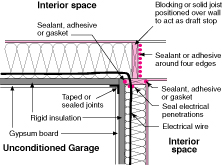
Figure 10
Band joists – Continuity of an exterior air barrier can be maintained at the band joist with sealed or taped housewrap or rigid foam insulation. Continuity of an interior air barrier can be maintained through a combination of cut foam blocks and sealant/caulk, rigid draftstopping (wood blocking) and sealant/caulk, or spray foam. Note that neither cellulose nor fiberglass (batt or blown) can be used for the air barrier. The air barrier detail on second-story band joists is important because it is inaccessible (covered by structural/finish floor and ceiling finish) after construction. The air barrier/thermal barrier detail is important on ground floor band joists because of the thermal bridge that can occur at the top of crawlspace foundation walls (as the result of the air barrier and thermal barrier moving from the outside to the inside of the building enclosure and termite inspection zones located at the top of basement and crawlspace foundation walls). Note that while fiberglass batts fulfill the requirement for protection from ignition in the open band joists, fiberglass batt material by itself cannot maintain the air barrier.
Attached garages – The building enclosure surfaces shared between conditioned space and an unconditioned garage must have a continuous air barrier. See Figure 10 and Air Sealing for details in terms of using sealants and rigid insulation to create a continuous air barrier between the attached garage and living space.
Drying mechanisms – In any climate, vapor control is based on the relationships among the following: the permeability of wall components, the type of cladding (reservoir or non-reservoir), the presence/lack/nature of an air space, and the magnitude/duration of the vapor drive (based on the relationship between the exterior and interior moisture content and temperature differences). The type of sheathing and housewrap used in any wall assembly must be based on an understanding of these inter-relationships. See “Insulations, Sheathings, and Vapor Diffusion Retarders” for more information. This wall assembly permits drying to the interior and limited drying to the exterior (vapor semi-permeable XPS insulation on the second story, OSB on the first story).
Drainage plane, air barrier, and vapor control – The drainage plane in this wall assembly is the layer of building paper on both stories. The air barrier is the interior gypsum board installed using the Airtight Drywall approach (see Air Sealing Details). The wall and roof assemblies in this building are “flow-through” assemblies, with some degree of vapor permeability in all components of the wall and roof. This bi-directional drying is the preferred approach in Mixed-Dry climates. The most common exterior rigid insulation used in this assembly is expanded polystyrene (EPS), a semi-vapor permeable sheathing.
Rough opening flashing – Window and door flashing details are wall assembly or cladding specific and depend on whether the windows are installed before or after the drainage plane. Refer to the Water Management Guide for more information.
Advanced framing – This wall assembly employs all of the advanced framing methods, including structural bracing rather than sheathing on the first floor. For advanced framing details, see Using Wood Efficiently. For information on the inset shear panel developed for a comprehensive approach to advanced framing in seismic regions, see Figure 11 and Design Guidance for Inset Wood Shear Panels.
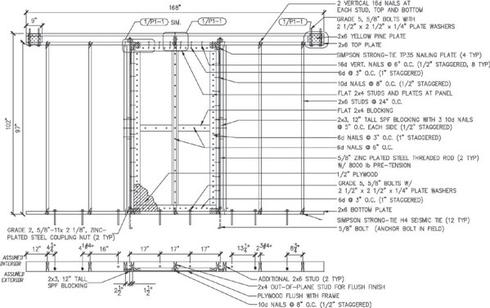
Figure 11Framing on slabs – Installing a capillary break between the sill plate and a concrete slab on all walls—exterior, interior, partition—is good practice. A closed cell foam sill sealer or gasket works well. Alternatively, a strip of sheet polyethylene can be used. This isolates the framing from any source of moisture that may be either in or on the concrete slab (and using sill sealer on all walls maintains the same wall height).
Soil gas ventilation – The sub-slab to roof vent system handles conditions that are difficult if not impossible to assess prior to completion of the structure—resultant confined concentrations of air-borne radon, soil treatments (termiticides, pesticides) methane, etc. The cost of this “ounce” of prevention is well balanced against the cost of the “pound” of cure.
Sub-slab stone bed - The four-inch deep, 3/4-inch stone bed functions as a granular capillary break, a drainage pad, and a sub-slab air pressure field extender for the soil gas ventilation system. Without it, a soil gas ventilation system is not practically possible and the only capillary break between the slab and ground is the polyethylene vapor barrier.
Thermal barrier - The heat loss through the slab perimeter is significant enough to warrant slab-edge insulation.
Vented attic – Soffit and ridge vents provide more effective attic ventilation than gable-end vents. Gable exhaust fans do not provide effective attic ventilation. They are generally temperature-controlled, when relative humidity is often the condition that requires higher ventilation rates. They can also depressurize the house causing loss of conditioned air. Generally, the area of the gable and soffit vents, combined with the leakage of the attic ceiling, is such that the fan pulls air not just from the exterior vent but from the conditioned space below.
Climate Specific Details
- Mechanical systems
- Heating – Sealed combustion hot air furnace. Sealed combustion means that the unit can be located within the conditioned space with no compromise in indoor air quality or combustion safety.
- Cooling - Evaporative cooling is prevalent in Mixed-Dry Climates. We recommend refrigerant cooling in high performance homes in this climate region for three reasons:
Refrigerant cooling permits year-round controlled ventilation; evaporative cooling does not.
Evaporative cooling can be prone to moisture and indoor air quality problems without frequent and diligent system maintenance, refrigerant cooling is not.
While there can be a slight energy penalty with refrigerant cooling in comparison to evaporative, this penalty must be balanced against the year-round comfort provided by refrigerant cooling (evaporative cooling has difficulty supplying comfort in high humidity situations) and the substantial water savings associated with refrigerant cooling (a growing issue in mixed-dry climates).
Follow appropriate sizing procedures. See the following for more detailed information: Cooling System Sizing Pro.
Ducting - Single return requires transfer grilles to provide path and avoid pressurizing bedrooms, as shown in the figures at right. Appropriate sizing for ducts, including these pressure relief methods, can be found see Figures 12a-d or go to System Sizing.
Figure 12a-d
Controlled mechanical ventilation - Intermittent central-fan-integrated supply, designed to ASHRAE 62.2P rate, with fan cycling controls set to operate the central air handler as much as 33% of the time, but not less than 25 % of the time, occurring within at least every three hours to provide ventilation air distribution and whole-house averaging of air quality and comfort conditions (installed cost: $125 to $150). Include a normally-closed motorized damper in the outside duct with the AirCycler® FRV control (installed cost: $50 to $60). See Figures 13, 14 and 15.
Figure 14
Figure 15 - Interior Closet Configuration
Termite management – Termites are best managed with a three-pronged approach that deals with the three things termites need—cover from sunlight, moisture, and food (wood or paper):
Reduced cover – Keep plantings 3 feet away from the building perimeter, thin the ground cover (wood mulch or pea stone) to no more than two inches depth for the first 18 inches around the building, and maintain any termite inspection zone on the exterior of the foundation above grade.
Control moisture – Maintain slope away from building as shown, carry roof load of water at least three feet away from building, and make sure that irrigation is directed away from the building.
Chemical treatment – Use an environmentally-appropriate soil treatment (such as Termidor®) and a building materials treatment (such as Bora-Care®) for termite-prone near-grade wood materials.
Inter-relationship of first three points – Since a builder and a homeowner’s ability to employ or stick to each of the three strategies above will vary, make sure that an inability to fully employ one strategy is compensated for by complete rigor with the others. For example, if for some reason, chemical treatment of soil or building materials is not an option, then complete rigor in moisture control and ground cover is required.
Landscaping for wildfire control – keeping woody materials of any type, living or otherwise, away from the building is good practice in dry climates where wildfire presents a significant risk.
Field Experience Notes
HVAC commissioning – The most efficient equipment means little if the system is not set up and started up properly. Follow high performance start-up procedures. In dry climates, it is generally a good idea to set up the air distribution fan to run a little longer at the end of each cycle to bump up the sensible efficiency.
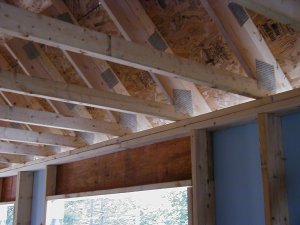
Figure 16
Energy trusses – There are a number of different truss configurations that yield greater depth at the heel, but they vary quite a bit in cost. The truss shown in Figure 16 (sometimes called a “slider” truss) has proven to be among the most cost-competitive. And of course, the pitch of the roof affects just how much insulation you can get at this location, regardless of the type of truss.
Advanced framing - For a technical resource that may help with resistance to advanced framing methods from local code officials, see the Building Safety Journal article written by Nathan Yost of BSC.
Slabs – In dry climates, it is quite common for builders to use a sand layer in between the polyethylene sheet and the cast concrete to prevent differential drying and cracking problems. This moisture-holding layer should never be placed between the poly and concrete. Differential drying and subsequent cracking should be handled with a low water content concrete and wetted burlap covering. See this technical resource for more information.
Single story homes and unvented/conditioned attics – Keeping all ducts and HVAC equipment in conditioned space with slab-on-grade, single story homes can be accomplished by moving the thermal barrier and air barrier up to the roof line, making the attic an unvented, conditioned space. Below are the associated building science points to consider when making the change to an unvented roof/conditioned attic:
- Air sealing details – Unvented assemblies — walls or roofs — are robust when the air sealing is robust. The hardest spots are not the fields but the margins/edges of assemblies. Spray foam applied at the margins (truss/rafter end blocking) may seem more expensive than cutting in air stops and caulking between each truss or rafter, but the labor savings and air sealing quality of spray foam are clear.
- Cavity insulation - Cellulose netting or fiberglass batt supports create the insulation “belly” and accommodate cavity fill depth that exceeds the depth of the truss top chord.
- Local acceptance - This assembly may require discussion with the local building code official. See our Unvented Roof Summary Article for assistance.
- HVAC configuration – See Figure 15 Interior Closet Configuration for the basic HVAC setup in this structure.
- Moving this assembly to Mixed-Dry Climates – If an unvented roof/conditioned attic assembly is employed where the coldest monthly average temperature drops below 45°F, we recommend that a rigid insulation be added exterior to the structural roof deck to warm the assembly to the interior of the rigid insulation, thereby reducing the potential for condensation problems in the structural roof deck. See Figure 18 and the following technical resource for more information: “Insulations, Sheathings, and Vapor Diffusion Retarders.
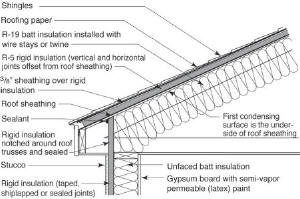
Figure 18
Tile roof – Tile roofs perform particularly well in this climate, in terms of heat rejection. See Energy Star Roof Product List for more information on roof tile with high emissivity and high reflectivity, particularly important with unvented, conditioned attics.
Material Compatibility and Substitutions
Interior latex paint - The substitution of low permeability interior finishes (vinyl wall paper, oil-based paints) for latex paint is strongly discouraged as drying to the interior is important in mixed climates.
Exterior sheathing materials – In the second story of this assembly, the reservoir cladding means that a moisture sensitive material such as fiberboard should not be used. On the other hand, the lack of cavity-warming exterior insulation means that an impermeable sheathing such as thin-profile structural sheathing (e.g. Thermo-Ply®, Energy Brace) should not be used. Plywood is an acceptable substitution for OSB in this wall assembly. For more information, see the Building Materials Property Table or “Insulations, Sheathings, and Vapor Diffusion Retarders."
Cavity insulation materials – Acceptable cavity insulation includes any that have a relatively high vapor permeability—cellulose, fiberglass, foam (as long as air sealing is accomplished by a separate component or system when cellulose or fiberglass is used). User discretion can be based on properties other than building science.
Flooring - Because curing concrete releases significant moisture for several months after being cast, we recommend that a low w/c concrete ratio (≤ 0.45) be used to protect the integrity of finished flooring. We recommend that vinyl flooring not be installed over a concrete slab.
Gypsum wallboard –Areas of potentially high moisture, such as bathrooms, basements, and kitchens, are excellent candidates for non-paper faced wallboard systems (e.g. James Hardie’s Hardibacker™, GP’s DensArmor™, USG’s Fiberock™). In addition, paper-faced gypsum board should never be used as interior sheathing or backer for tub or shower surrounds where ceramic tile or marble (any material with joints or grout lines) is used as the finish.
HVAC – A hot water-to-air coil in an air handling unit can be used to replace the gas furnace hat exchanger. The coil can be connected to a standard gas water heater with a draft hood located in the garage, outside the conditioned space. Alternatively, the gas water heater can be sealed combustion (or power-vented) and located within the conditioned space. However, before you make this change, be sure to read the following technical resource: “Combo Space/Water Heating Systems – “Duo Diligence."

